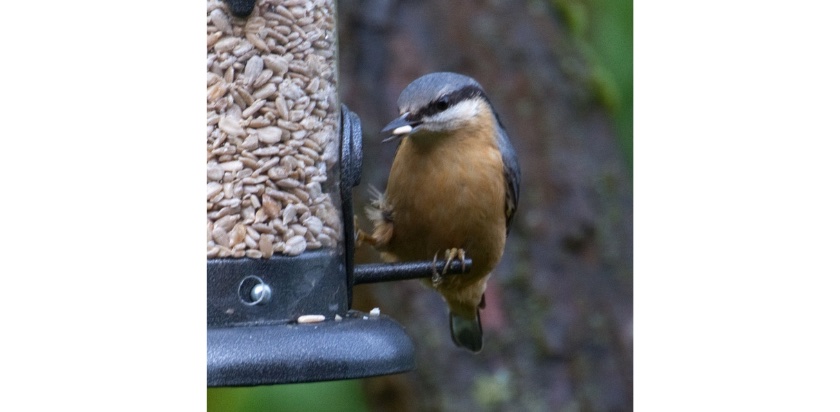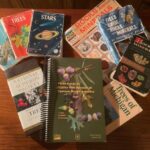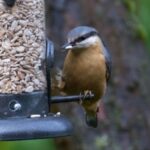Despite what you read, feeding wild birds in America did not begin in 1845 when Henry David Thoreau fed the birds at Walden Pond in Concord, Massachusetts. Americans had been tossing breadcrumbs to the birds long before his visit to the pond. Thoreau just wrote about it.
Thoreau also wrote:
“He who cuts down woods beyond a certain limit exterminates birds.”
–Henry David Thoreau
Today, during yoga class, out on the patio of the community center, the birds’ chorus wafted down from the honey locust trees. During savasana (“corpse pose”) at the end of the class, it was drowned by a duet of chainsaw and wood chipper a block over. This spring’s tree-trimming assault, led by the City of Royal Oak and/or Detroit Edison and carried out by Asplundh, and other tree-massacring companies, is as radical as I’ve ever witnessed. And the tree trimming is taking place during nesting season. A big no. Hard to feel the namaste.
Meanwhile, on the Nextdoor app, the debate rages on. Does feeding wild birds attract rats? Should we empty our birdfeeders?
I wondered what I could learn about the relationship between feeding the birds and increasing the rat population.
How many of us feed wild birds?
Today, more than 50 million Americans put out—all together—over a billion pounds of birdfeed each year.
The estimate that 1 out of 3 American adults feed wild birds in their backyards, makes feeding the birds the second most popular hobby in the U.S., after gardening.
Why do people feed the birds?
Reasons include:
- Bird feeding is an inexpensive activity that is both entertaining and educational and can be shared by children and adults.
- Watching birds feeding is an excellent form of relaxation and serves to relieve stress.
- Bird feeding represents a basic connection between humans and nature. Bringing nature to us not only connects us to the other creatures with whom we share our planet but also provides us with the pleasure and satisfaction of helping wild birds survive and thrive, especially when the weather is inhospitable and while birds are raising their families.
- Spiritually, practices like feeding the birds help you to drop your self-centered concerns and become more other-centered. Being more other-centered expands your sense of self and increases true self-confidence.
Why do wild birds need feeding?
Consider:
- A typical backyard bird does not weigh as much as two nickels.
- Birds live their entire lives outside, battling the elements, which in Michigan include: cold temperatures, wind, sleet, and snow.
- Birds consume 15% of their body weight overnight just keeping warm enough to survive.
- Birds spend most of their waking hours searching for food, with or without the help that humans can provide.
My family’s experience feeding the birds
For some people, the act of feeding birds is so basic to everyday life that we don’t even think about why we do it. It”s just part of our day-to-day experience. Feeding the birds has been a part of my life since childhood.
The only birdfeeder in the neighborhood
When I was in elementary school my mother built a birdfeeder. She has confirmed my memory that she used a 4 x 4” wooden column (left over from the building of our house) as the post and then using wood scraps, built a feeding tray. Half of the length of the tray had two walls and a roof to make a little shelter for the birds in inclement weather.
My dad dug a hole and installed this birdfeeder in a garden that could be seen from the kitchen window and my parents’ bedroom. My mom painted the entire thing white except for the roof over the feeding tray. The roof she painted black. It was very substantial and a pretty cool-looking birdfeeder.
Although I really had nothing to compare this birdfeeder with, as I never knew of anyone else in our entire neighborhood ever feeding wild birds. But my mother did.
One of our family stories is of the battle my mother had with one particularly fat fox squirrel. (Although maybe he wasn’t so fat when he first started coming around.) Not many squirrels visited our yard. A field stretched behind our backyard, and either animals that frequented there were keeping the squirrel population down or perhaps the other squirrels found plenty to eat in the wild of that field.
But not this one squirrel, who had discovered what we were pretty sure he thought of as a feeding station built just for him. When he was busy eating and my mom would rap on the window, trying to interrupt him from gorging himself on birdseed not put out for him, he’d irritably chatter back at her.
Mom vs. Squirrel
One winter morning, when my mom was getting us breakfast, she saw this squirrel heading up the post to the seed. She quickly filled her spaghetti pot full of water. Out the side door she ran—in her nightgown—intending to throw water on that thieving squirrel. We ran to watch from the window.
When my mom went to fling the water from the pot at the squirrel, she, inadvertently, let go of the pot handles. The water arced out just before the pot itself took to the air. The squirrel got drenched a second before the large Revere Ware pot hit the birdfeeder. Did the pot hit the squirrel as well as the feeder? It all happened too fast to say for sure. But the squirrel did fly off the feeder, not to be seen again.
A New Phase
My mom fed wild birds for almost 60 years, from the time she constructed that bird feeder until just recently. In 2018, once they had both retired, my parents moved from their historic home in Northville to a condo in Plymouth. There, every morning, after breakfast, my mom would put out one-half cup of food in a dish. Both of my parents would sit in their designated bird-watching chairs in their living room, commenting on the birds that came to eat from their deck. They stayed until all of the seed was gone and then brought the feeding dish into the house. If I was visiting, I joined them in a front-row seat for the show. My parents and the birds–best family entertainment ever!
The New Rule
A few years after they moved in, however, the condo association instituted a new rule. Because board members suspected rats were in the area—which would make sense; the small condo community is near a wooded branch of the Rouge River– feeding wild birds is now forbidden. Despite the neighborhood being adjacent to an area where opossums and coyotes should easily keep the rat population under control.
At the end of his life, my dad enjoyed watching the birds feeding more than anything else being with family. He died on March 13, 2021. My mom, who will be 95 tomorrow, watches any bird she spies but strictly adheres to the no-feeding-the-birds rule. She likes her condo and her neighbors and doesn’t want to cause any trouble. I suspect if my parents had known they’d not be allowed to feed wild birds at their condo, they might have chosen to live elsewhere.
The greatest gift for my mom would be to be able to put out a half cup of birdseed a day and watch her feathered friends touch down for a snack on the other side of the door to her deck. They still remember her, and when she goes out on her deck, they raise quite a ruckus!
The sad part of this is that there’s a very simple solution that would allow feeding wild birds while repelling rats . . .
How to Feed the Birds while Repelling the Rats
Feed the bird and repel the rats by following this two-step process.
Step #1
Pick the right kind of seed to prevent attracting rodents and other mammals to the area around your birdfeeder.
Choose sunflower kernels (i.e., with the shell removed). Not fillers—grains like millet or sorghum. Not peanuts. Not whole sunflower seeds.
Sunflower kernels are the most popular bird food in terms of what the birds like. The birds won’t let a sunflower kernel fall without pursuing it. But the fillers (and sunflower seed shells) end up on the ground and may attract rats and other rodents.
Step #2
Buy (or make) the sunflower kernels hot!
It is easy to keep rodents from your feeder. Mammals—other than some humans like me—hate spiciness. But birds can’t taste (or feel) it!
“We know that birds have different taste receptors from humans. Because birds are biologically unable to register the effects of capsaicin—the chemical that makes peppers feel “hot” in your mouth—they don’t feel the burn like we do.
“And hot peppers provide more than just a meal for birds. Chilies are a good source of Vitamin A, which is known to improve feather quality, color, and shine.”
“Hot peppers are also widely believed to have health benefits for humans, including providing antioxidants, immunity support, and possibly even pain relief. The same may be true for birds.”[1]
Several birdseed companies have capitalized on neighborhoods’ interest in attracting birds while repelling rats. Other brands are available, but I’ve used Cole’s Wild Bird Products. Cole’s Hot Meats* are nutritious sunflower kernels (aka “meats”) infused with fiery hot chilies. No waste, no mess. Full of vitamins A and D as well as carotene, chili peppers are an excellent natural source of nutrition for birds. Cole’s motto? “Birds can’t get enough of the hot Cajun flavor.”
Rats, other rodents (e.g., squirrels), and any other mammals (e.g., raccoons) don’t even like the smell. They can’t get away from this spicy food fast enough!
Rat problem solved.
“Come feed the little birds, show them you care
And you’ll be glad if you do
Their young ones are hungry, their nests are so bare
All it takes is tuppence from you.”“Feed the birds, tuppence a bag
Tuppence, tuppence, tuppence a bag
Feed the birds,” that’s what she cries
While overhead, her birds fill the skies.“All around the cathedral, the saints and apostles
Look down as she sells her wares.
Although you can’t see it, you know they are smiling
Each time someone shows that she cares.“Though her words are simple and few,
Listen, listen, she’s calling to you.
“Feed the birds, tuppence a bag
Tuppence, tuppence, tuppence a bag.”“Though her words are simple and few,
— From the 1964 Disney musical motion picture Mary Poppins, written by Robert Sherman / Richard Sherman
Listen, listen, she’s calling to you.
“Feed the birds, tuppence a bag
Tuppence, tuppence, tuppence a bag.”
[1] https://www.perkypet.com/articles/why-birds-are-immune-to-the-burn-of-hot-peppers
*NOTE: You can also purchase sunflower kernels and Cole’s Flaming Squirrel Sauce and make your own rat-repellent birdseed.








